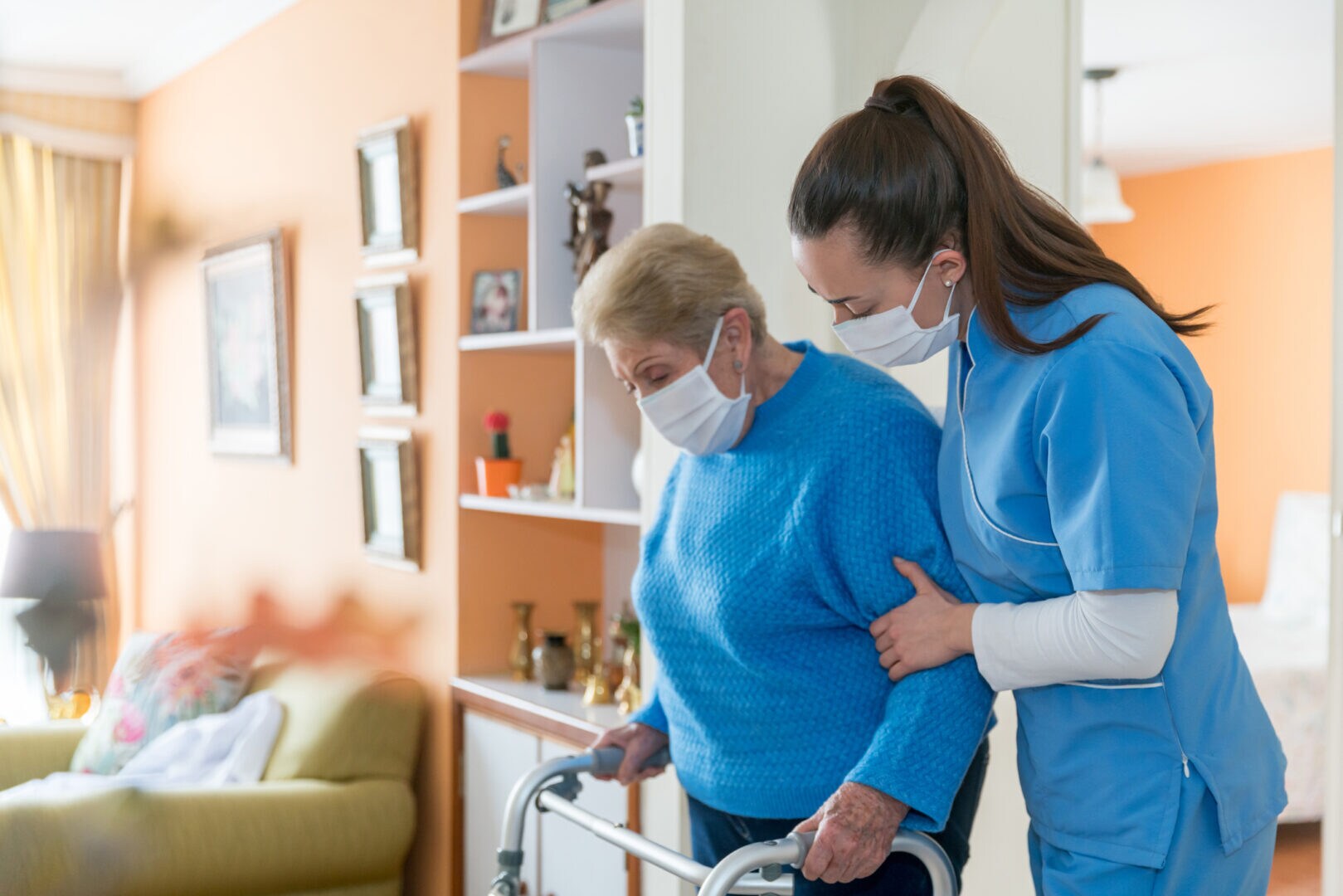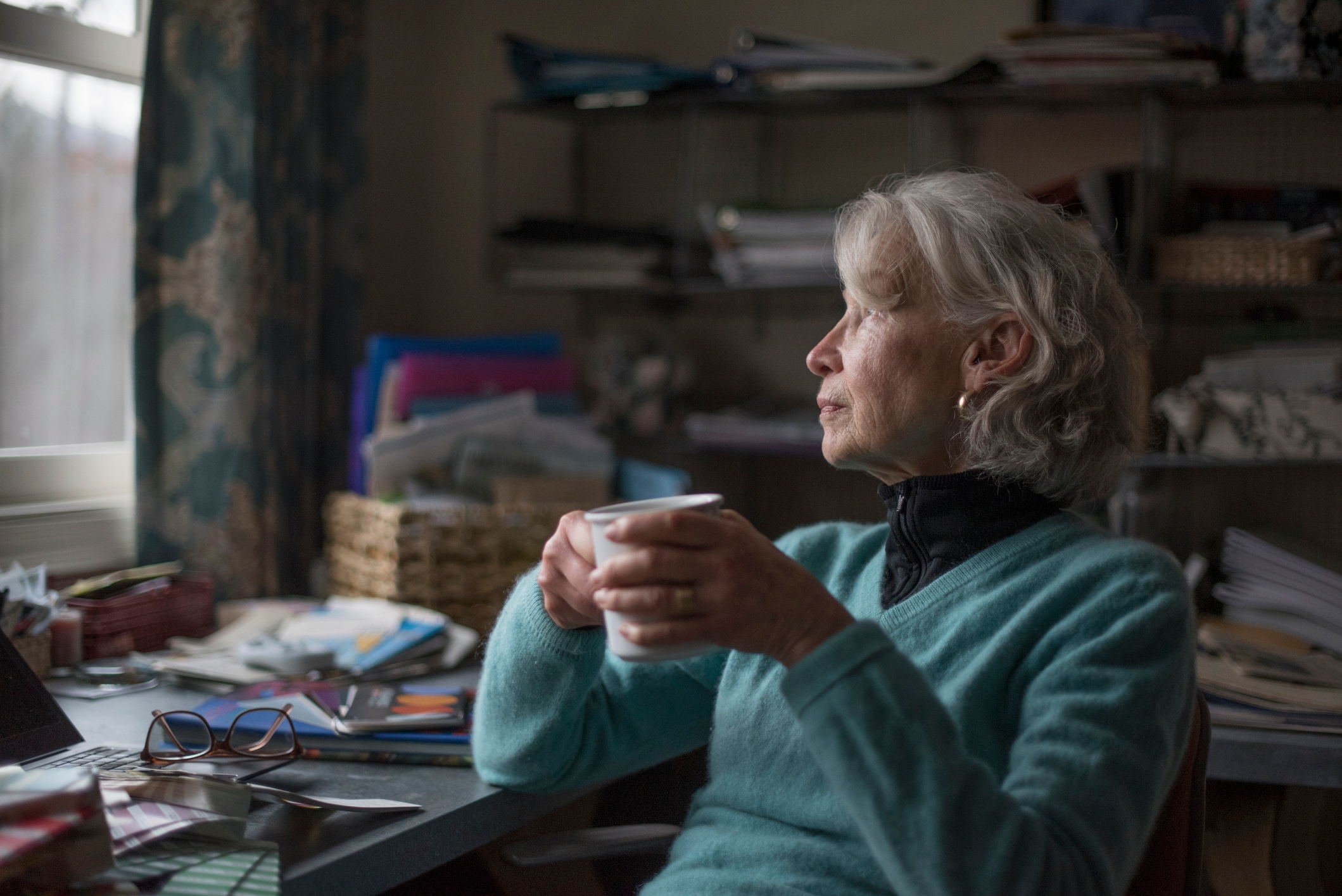As families settle into the third calendar year of the COVID-19 pandemic, some are experiencing what’s become a familiar fear: will their loved one’s nursing home be the next COVID-19 hotspot?
According to the Centers for Disease Control and Prevention (CDC), seniors who are 85 years old and older, as well as those with underlying medical conditions, are the most at risk of becoming severely ill or dying from COVID. However, almost all residents of a nursing home would be considered high-risk for severe disease, says Dr. Amesh Adalja, Senior Scholar at the Johns Hopkins Center for Health Security. And even if these residents are vaccinated, Adalja warns they may have blunted responses.
This is even more worrisome as the highly contagious omicron variant continues sweeping through the country — and now across nursing homes. According to a January 12 report from the American Health Care Association and the National Center for Assisted Living, long-term care facilities nationwide are currently seeing an “alarming” spike in COVID cases due to omicron.
The report states that according to the CDC, in the week ending December 19, nursing homes reported 4,361 COVID cases among residents and 5,919 cases among staff members. But less than a month later, in the week ending Jan. 9, the numbers shot up to 32,061 reported cases among residents and 57,243 employee infections.
Wondering how this latest surge is affecting long-term care facilities? Experts offer safety advice and insight.
Are nursing homes safe for older adults during the omicron surge?
When it comes to senior care facilities across the country, “nursing homes are on high alert right now,” Terry Fulmer, president of the John A. Hartford Foundation, which strives to improve care for older adults, tells ABC News. “Omicron is highly transmissible and is spreading through communities like wildfire.”
But the number of residents and employees who are vaccinated is influencing just how much omicron affects a nursing home, according to Adalja. “Omicron is going to be ubiquitous, and if someone is fully vaccinated, the impact will be severely blunted.” For those unvaccinated seniors, omicron is a clear and present danger, says Adalja.
The CDC found that fully vaccinated seniors 65 and older have shown a 94% reduced risk of being hospitalized due to COVID if they received both doses of either the Pfizer or Moderna vaccines. And on January 13, the U.S. The Supreme Court upheld the Centers for Medicare and Medicaid Services vaccine mandate for employees of federally funded hospitals, nursing homes and other healthcare providers. According to CMS, this will cover 10.4 million healthcare workers at 76,000 medical facilities.
Plus, as of January 12, 2022, 87.4% of nursing home residents were fully vaccinated and 63.4% have been boosted, according to the CDC. Additionally, the AHCA and NCAL report showed that although nursing home deaths have increased in recent weeks, the overall rate has drastically decreased — it’s now 9.47 times lower than it was in December 2020 due to vaccines and boosters.
All of these developments factor into how safe Adalja sees nursing homes now. “I think they are safer than in the past, primarily because of vaccines. However, they will always be at higher risk,” he says. “I think the Supreme Court ruling affirming the CMS vaccine requirement will go a long way to making them safer.”
Is the omicron surge affecting how nursing homes operate?
Nursing homes and assisted living facilities across the United States are seeing substantial outbreaks amongst their staff — and not just residents, says Harley Jones, U.S. COVID Response Lead at Project Hope.
As omicron spreads, nursing homes are currently seeing an unprecedented shortage as infection rates rise dramatically among staff, explains Sheila Molony, a professor of nursing at Quinnipiac University and a Gerontological Society of America fellow. “Staffing shortages were already a problem in nursing homes as long-term care facilities lost staff to COVID and/or to burnout,” she says. “Now, some homes are in crisis mode. They do not have the staff needed to provide basic care.”
According to an AHCA and NCAL report from December 10, 2021, nursing homes had already been hit harder during the pandemic than any other industry within the healthcare sector. Before omicron began surging, the nursing home workforce was facing a historic worker shortage with 234K fewer employees than pre-pandemic March 2020. To put that into perspective, physicians’ offices had actually gained 32K employees since the pandemic’s start, and hospitals had only seen a 1.7% reduction in workforce.
But omicron hasn’t just impacted who is working at nursing homes, it’s also affected how they are doing it. “Many nursing homes are back on lockdown to protect their vulnerable seniors,” says Alex Kronk, who works within senior care communities to explain Medicare and Medicare Advantage plan benefits. “Many are going back to having less common area socialization, such as eating meals in their room instead of a larger dining area.”
“Older adults may not make sufficient antibodies to protect them, but if their caregivers are fully vaccinated and boosted, they are less likely to acquire and transmit the infection.”
— SHEILA MOLONY, professor of nursing at Quinnipiac University
What precautions should senior living facilities be taking right now?
If you’re curious what measures your loved one’s facility should be taking at the moment, consider the following fundamentals of infection prevention, according to Jones:
- Strong PPE procedures
- Social distancing
- Use of alcohol-based hand sanitizers
- Cohorting of residents based on symptoms and positivity
- Diligent testing plans
And mandatory vaccines and boosters for both staff and residents are paramount, says Molony. “Older adults have weaker immune system responses to infections, which is why it is so important not only for them to be fully vaccinated and boosted, but also for the people who are around them,” she says. “The older adult may not make sufficient antibodies to protect them but if their caregivers are fully vaccinated and boosted, they are less likely to acquire and transmit the infection — essentially providing a shield of protection.”
What about breakthrough infections and boosters?
As time passes, particularly those 65 years and older will experience what Adalja describes as an “erosion against protection,” which makes boosters even more critical right now. “Nursing home patients, by definition, are more frail than community-dwelling seniors so boosters are even more important,” he says.
It’s clear that boosters make a dramatic difference in both the number of infections and the number of deaths, especially for people over age 65. According to the most recent CDC data, the rate per 100,000 individuals 65 and up for infections were:
- Unvaccinated: 635.54
- Fully vaccinated but no booster: 104.78
- Fully vaccinated with booster: 22.78
“You want to ensure that you know how your loved one is being kept safe, and more importantly, you want to be able to do your part in supporting those safety measures.”
— HARLEY JONES, U.S. COVID RESPONSE LEAD AT PROJECT HOPE
What questions should families ask nursing homes during omicron?
Regular communication with your loved one’s facility is essential, especially during this current surge. “You want to ensure that you know how your loved one is being kept safe, and more importantly, you want to be able to do your part in supporting those safety measures,” Jones says. “Remember that the staff and residents are doing their best. They are working long-hours and are dedicated to keeping your loved one safe.”
Some questions to consider asking:
- What is your mask policy for staff, residents and visitors? (The CDC updated its mask information on January 14, highlighting that certain masks offer better protection.)
- What is your infection prevention and control (IPC) program?
- What is your vaccination and booster policy for residents, staff and visitors?
- What are your protocols for contact tracing?
- What is your plan for keeping families updated and informed?
- How often are staff and residents tested?
- What is your PPE policy for visitors?
- What is the protocol for if the facility needs to temporarily shut down due to a staff shortage?
- What are your cleaning and disinfecting policies?
- What new precautions have you enacted due to the omicron surge?
- What are the parameters for determining if visitors will no longer be allowed?
- What’s the latest protocol for when someone tests positive?
If you want to keep track of how a specific facility or area is doing, CMS also has an incredible tool for looking into COVID-19 nursing home data for both staff and residents throughout the country.
The bottom line on omicron and seniors in long-term care
The biggest risk to senior loved ones, according to Jones, is that we become complacent in our approach to COVID protections like mask wearing, social distancing, washing hands and sanitizing surfaces.
“Complacency can help undue much of the progress we have made in keeping ourselves and our loved ones safe,” he says. And of course, “as health care professionals remind us daily, the most important thing we can all do is to get vaccinated.”





